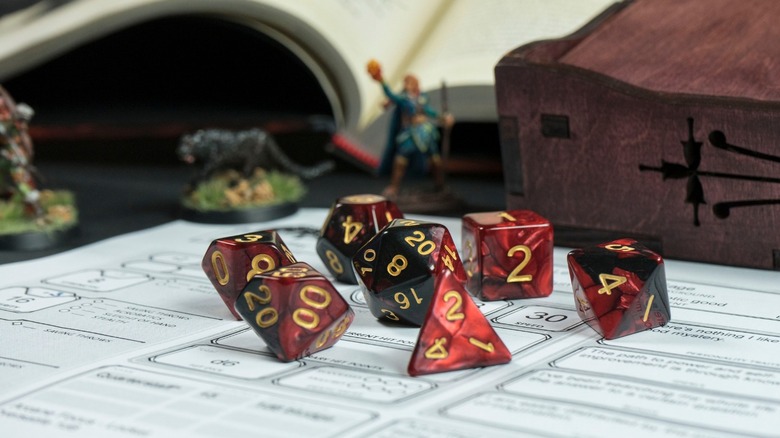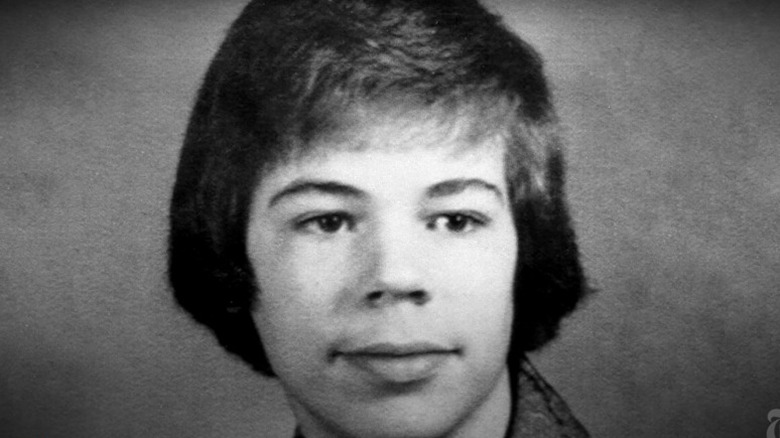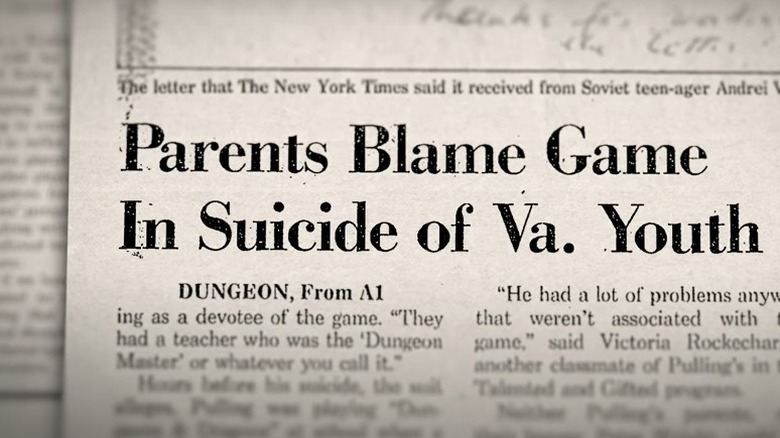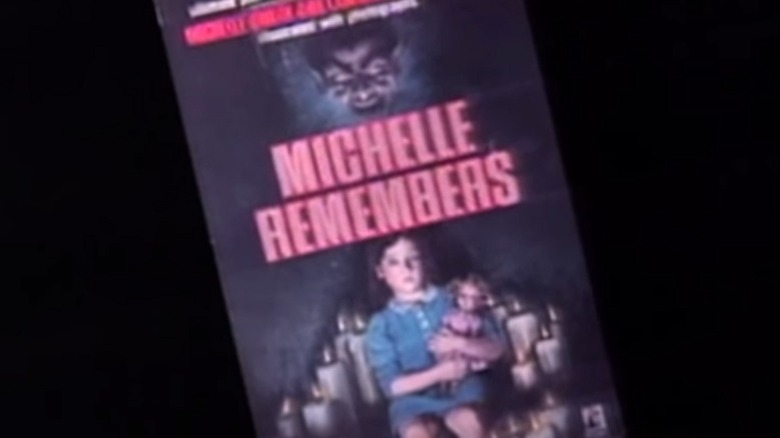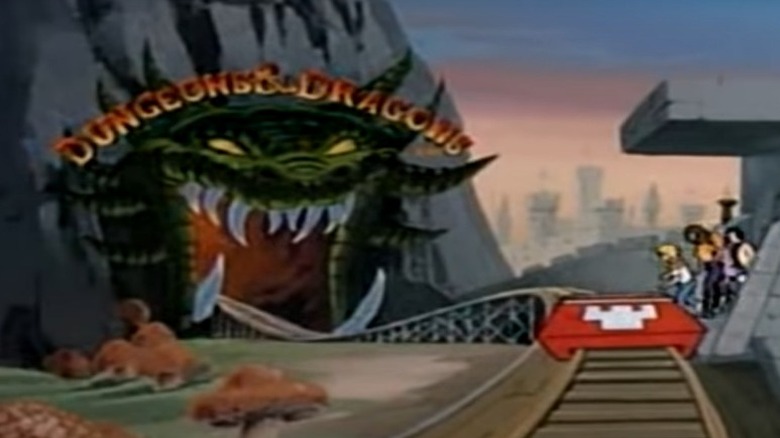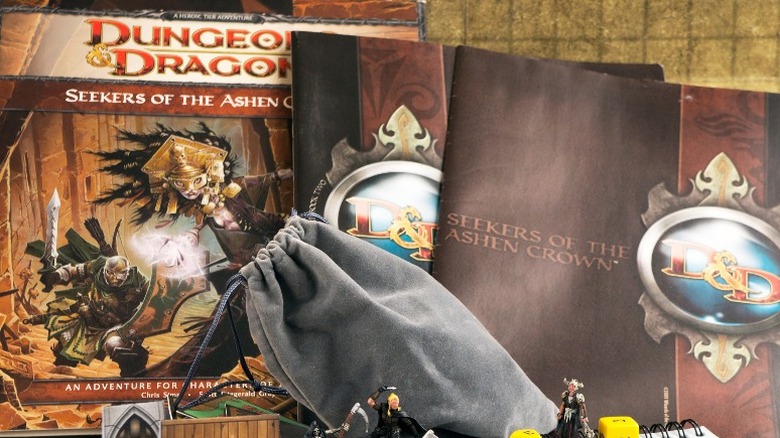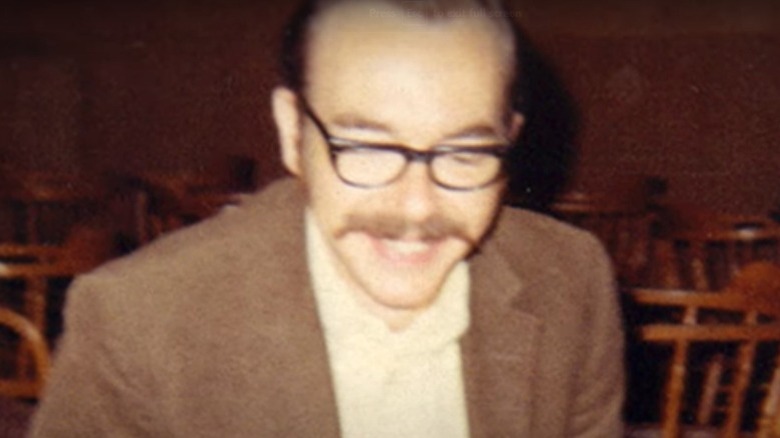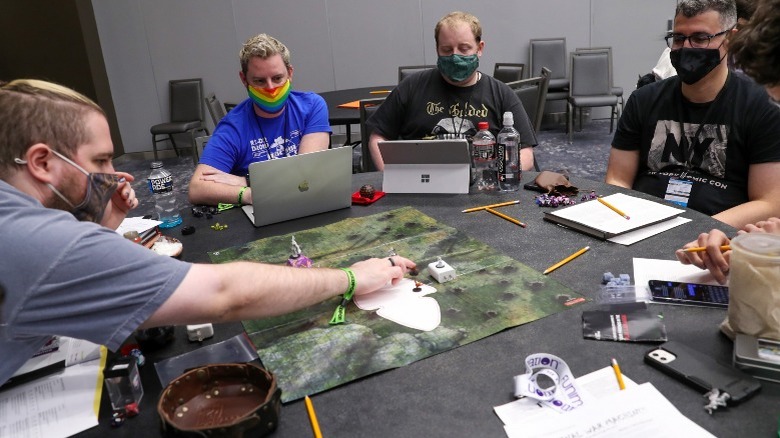The Dungeons & Dragons Panic Of The 1980s Explained
Fans of "Stranger Things" will have noticed that several of the show's most beloved characters are in the throes of an intense Dungeons and Dragons campaign in season four. Following the episodes, there is a mass hysteria escalating surrounding the play of the game, as the game and some of its participants are being blamed for murder in the small community of Hawkins, Indiana.
While the show is a work of fiction, the paranoia against D&D that it highlights is far from it. Throughout the 1980s and early 1990s, this popular role-playing game was the subject of intense controversy and heated televised debates. The game was a stand-alone topic on numerous daytime talk shows, the sole subject of seminars lecturing about the occult, and one of the central figures in the "Satanic Panic" crisis of the era.
For those who are unfamiliar with D&D, it has been a staple of science fiction and fantasy enthusiasts for nearly 50 years. This popular game was created in 1974 by the late Gary Gygax and published by TSR (per BBC News). Years later, the rights were purchased by gaming giants Wizards of the Coast (a subsidiary of Hasbro) in 1997. Though the game is experiencing record successes today, there was a time when angry mobs led by religious fundamentalists wanted it banned for good.
The disappearance of James Egbert created a small panic
You could build a strong case arguing that the first domino to fall in the D&D hysteria was the disappearance of 16-year-old James Dallas Egbert III in 1979. Egbert was a child prodigy and computer genius, who, according to BBC News, was enrolled at Michigan State University. Egbert's concerned parents hired a private investigator to search for their son after he vanished from his dorm room on August 15, 1979.
Believer Magazine reports that Egbert and his friends enjoyed playing D&D in the steam tunnels beneath the university. The detective hired by Egbert's parents wrongfully concluded that their son had been playing the game in the steam tunnels when he disappeared. A press conference was given by the detective, William Dear, which led to national attention on the Egbert case and D&D (per National Library of Scotland). Many began to blame the role-playing game.
What really happened? Egbert was depressed and had left his dorm to attempt suicide in the steam tunnels. Days later, he left for Louisiana and began working in an oil field. When he realized his disappearance was getting national attention, he turned himself in. Dear met him and escorted him back to his parents. Egbert's case was referred to by media as "The Steam Tunnel Incident." According to Dear, Egbert revealed that he was secretly gay and chronically depressed. Sadly, Egbert attempted suicide again within a couple years and succeeded.
If you or anyone you know is having suicidal thoughts, please call the National Suicide Prevention Lifeline at 1-800-273-TALK (8255).
Pop culture used the Steam Tunnel Incident as a lever for profit
Enter Rona Jaffe. This Cosmopolitan writer-turned-novelist cranked out the 1981 novel "Mazes and Monsters," which focuses on a group of college students who begin to play a role-playing game similar to Dungeons and Dragons. One of the students becomes obsessed with the game and has a psychotic break, nearly killing someone he believes is a monster from the realm he believes to be on a quest in (per Kirkus).
Per BBC, the book is loosely based on the "Steam Tunnel Incident." To make matters more interesting, CBS adapted the novel for a made-for-TV screenplay and aired the production in a prime-time slot on December 28, 1982 (via IMDb). The movie featured veteran actor Murray Hamilton (the mayor in "Jaws"), who plays a cop that's convinced that a role-playing game can be responsible for the murder. Also in the movie are Chris Makepeace ("Vamp" and "My Bodyguard") and a 26-year-old Tom Hanks. The latter play two college students who, like in Jaffe's novel, get a little too wrapped up in playing a certain roleplaying game in caves near their university.
Unlike Egbert in real life, the characters in the book and the movie have happy endings. The attention from the book and the film were keeping the unwarranted fears about D&D in the minds of concerned parents and religious groups. It would take another well-publicized suicide to marry the two groups and allow them to take on the game together.
Irving Lee Pulling's suicide was blamed on D&D
Irving Lee Pulling II was a talented and gifted student at Patrick Henry High School in Hanover County, Virginia. On June 9, 1982, Pulling arrived home from school, just days before final exams were to take place. He put a gun to his chest and pulled the trigger, killing himself (via The Washington Post). A cursory search of Pulling's room by police investigators turned up a suicide note that referenced what the police would later call "mystical phrases." Pulling's room was also filled with sci-fi and fantasy posters, toys, and other paraphernalia. Oh, and they turned up a TSR D&D manual.
Pulling had been involved in his high school's D&D club, where a teacher had served as the dungeon master. Pulling's parents immediately concluded that the game was responsible for their son's death. In a 1983 lawsuit filed against Patrick Henry High School, it was alleged that Pulling had been playing the game at the school in the hours before he took his own life. During that gaming session, another player put a "curse" on Pulling, causing him severe emotional distress.
Those who knew Pulling from school claimed that, though intelligent, he had a lot of struggles fitting in. He had recently tried to run for class office but was depressed that no one would be his campaign manager. He was noticed scrawling "life is a joke" on a blackboard in the days leading up to his death.
If you or anyone you know is having suicidal thoughts, please call the National Suicide Prevention Lifeline at 1-800-273-TALK (8255).
Pulling's mother formed Bothered About Dungeons and Dragons (BADD)
Distraught by her son's untimely death and wanting to warn others of what she believed to be an evil influence, Irving Pulling's mother Patricia formed Bothered About Dungeons and Dragons (B.A.D.D.) in 1983. She recruited psychiatrist Thomas Radecki, the director of the National Coalition on Television Violence (NCTV) to aid her in joining forces with several loosely organized anti-D&D groups led by Christian fundamentalists (per Journal of Religion and Popular Culture). Psychology Today reports that the newly formed B.A.D.D. believed that D&D was a leading influence in bringing youth over to Satan.
The rationale was that role-playing is an often-used tool in therapy for overcoming traumatic experiences. If this exercise can lead to changes in a patient's psychological state, then it could certainly lead to negative changes in their mental health if violence, evil, and sexual fantasies are woven into the role-play.
The Journal of Religion and Popular Culture further adds that Pulling and her new group claimed that D&D had a demonic influence behind it, and compared it to the "evils" of heavy metal music and the rise of neo-paganism in the United States. Pulling and her associates began a public campaign, distributing their propaganda to police departments and schools nationwide. Pulling appeared on talk shows, made public appearances as a speaker, and began to petition public officials. The public war between outraged parents and Dungeons and Dragons was on.
The controversy led to increased interest and sales
With all of the negative attention role-playing games were receiving throughout the rest of the 1980s and early 1990s, you might be inclined to think that sales would suffer. As it turns out, the old adage, "there's no such thing as bad publicity" rang true for TSR and their controversial game.
TOR reports that during the aftermath of "The Steam Tunnel Incident," sales of D&D manuals quadrupled. According to CBR, despite Patricia Pulling and B.A.D.D. trying their best to convince the world that playing D&D and listening to heavy metal music was a pathway to Satan himself, sales of the game continued to soar throughout the controversy. One might argue that the widespread campaign that Pulling and her cohorts engaged in only led to a widespread curiosity about the game, resulting in more manuals being sold.
The popularity of D&D eventually spilled over into other facets of popular culture, inspiring video games, board games, and a whole host of props and figures you could play the original game with. Fans of the game were also introduced to countless novels based on the realms and characters, D&D comic books, posters, and eventually a feature film. It might be safe to assume that Pulling and B.A.D.D.'s war on D&D actually helped TSR.
The D&D controversy was the subject of a 1985 60 Minutes episode
The controversy surrounding D&D had been the subject of media stories since James Egbert's disappearance in 1979. But it was a weekly news program on CBS that vaulted the hysteria into the living rooms of everyday Americans.
In 1985, the award-winning "60 Minutes" show aired a special broadcast devoted to D&D. Hosted by Ed Bradley, the show opened by stating that a popular game with children was believed by some adults to cause suicide and murder. Appearing on the program were Patricia Pulling and Thomas Radecki, who claimed that the game was responsible for the deaths of 28 people (via National Library of Scotland).
Bradley also interviewed a visibly frustrated Gygax, who pulled no punches when talking about those parents who were behind the hysteria. He stated: "This is make-believe. No one is martyred, there is no violence there. To use an analogy with another game, who is bankrupted by a game of Monopoly? Nobody is. The money isn't real ... There is no link, except perhaps in the mind of those people who are looking desperately for any other cause than their own failures as a parent"
The controversy surrounding D&D in the 1980s was part of the Satanic Panic paranoia
When you study the history surrounding the D&D controversy of the 1980s and early 1990s, it's easy to see that it fits in nicely with the "Satanic Panic" the United States was experiencing at the time. Organizations like B.A.D.D. painted the role-playing game with a devilish brush, claiming that the game had demonic influences behind it.
D&D wasn't the only target of religious groups and paranoid parents. "Satanic Panic" created a negative focus on numerous musicians, films, books, comics, and other forms of media. But that isn't where the tragedy lay. The panic, pioneered by misguided mental health professionals, began when a psychiatrist and author Lawrence Pazder released "Michelle Remembers," an alleged true story of satanic ritual abuse that was revealed through years of hypnotherapy (per The National Post). The book set off a wave of paranoia. Suddenly, there were hundreds of "Michelles" coming forward about their own abuse, triggering what mental health professionals would later call "false memory syndrome."
With so many people believing that there was an underground of satanic cults abusing their kids, it's no wonder that so many people were falsely accused of ritual abuse. Doctors, teachers, pre-school employees, and others were accused in a nationwide witch hunt, some convicted with zero physical evidence. In 1995, Virginia Commonwealth University published a report stating that "Virtually no evidence was ever discovered to support the allegations of satanic cult activity" (via Crime Reads).
In the middle of the controversy, there was a D&D Saturday morning cartoon
Those of us who are old enough to remember Saturday morning cartoons in the 1980s might recall an action-packed 30-minute series that aired on CBS every Saturday morning. For three solid seasons, CBS aired "Dungeons and Dragons," an animated series that existed in the middle of all of the panic surrounding the tabletop game. This series centers around a group of teens who got on board the Dungeons and Dragons ride at their local carnival. Midway through the ride, a portal was opened, sucking the group inside and transporting them to another realm. Led by the elderly Dungeon Master that discovers them upon their arrival, they are assigned permanent roles that will aid them in their ultimate quest of returning home. Their combined skills take them through 27 harrowing episodes, fighting various monsters and demons along the way.
The series had a host of familiar voices. Veteran voice actor Frank Welker provided the voice of Uni, the teens' newly found baby unicorn (per IMDb). "Happy Days" fans will recognize the voice of Donny Most, who played the cavalier. For those who might recall the series "Eight is Enough," you'll be familiar with the voices of the ranger and the magician, played by Willie Aames and Adam Rich.
Tuning in each Saturday from 1983 to 1985 might make a kid forget that there was an orchestrated battle against the game this beloved cartoon was based.
TSR removed satanic monsters from the game
Even though TSR was experiencing record sales during the "Satanic Panic" years, the company decided to go into damage control mode to be on the safe side. Frank Mentzer, who helped design several manuals for the game with Gary Gygax, was put into the position of PR and spokesperson (per Nerdist). He appeared on talk shows, combatting the unwarranted fears some members of the public held about D&D. He appeared on radio and tv talk shows, including a 1981 appearance on "Good Morning, America." His message was simple enough. Mentzer was insistent on the fact that D&D was entirely fiction. The magic and the spells cast in the game by players were not real and were merely a part of imaginative gameplay. He discussed that role-playing games had a strong moral component to them, where the players were battling evil.
To placate some religious groups, TSR removed some of the imagery and monsters from their manuals by the time the new edition of the game was released in 1989. But as the country was in the middle of the "Satanic Panic" era, it's arguable that distancing themselves from some perceived "evil" illustrations was a moot point.
The Pulling Report was published in 1990
By the early 1990s, the United States was beginning to get a little message fatigued by the imagined dangers of D&D. Helping kick this new attitude off was the publication of "The Pulling Report," by avid gamer and D&D enthusiast Michael Stackpole. BBC News reports that Stackpole noted the many errors in statistics made by Patricia Pulling and B.A.D.D. throughout their public campaign against the game. The report cited instances of professional credentials that had been exaggerated or falsified their claims, including Pulling's assertations that she was an "expert" in any way.
RPG Studies has the report in its entirety. In the report, Stackpole accuses Pulling of giving false and misleading information to police officers that attended cult crime seminars, and of giving equally false and misleading information to school districts. The Pulling Report also cites numerous times that Pulling claimed D&D was responsible for a crime but offers evidence that the game really had nothing to do with it.
The Pulling Report began to erode the credibility of D&D critics like Pulling and Thomas Radecki, bringing to light that the supposed "experts" might not really have a grasp on what was really happening.
The game still enjoys popularity today
Despite all of the controversy, the death of Gary Gygax, and the draw of the ever-growing video game industry, Dungeons & Dragons is still a force to be reckoned with. The brand has grown exponentially since the 1980s and all the panic surrounding it. NBC News reports that in the year 2020, COVID-19 lockdown restrictions only fueled the popularity of the game more, as fans worldwide began to draw in friends and family members who were part of their COVID-19 bubbles. Adding to that growth was the online D&D community, which made virtual rolls of the dice just as fun as the physical ones on the tabletop.
But it wasn't just COVID-19 that fueled the 33% jump in D&D sales. NBC News also reports that the game had been experiencing growth year after year since 2014. As fans of the original game are now well into adulthood, they have begun teaching their children, and even their grandchildren, the ways of the most popular role-playing game of all time. Younger fans who might have begun by playing card games like Spellfire or Magic: The Gathering has been lured over to the D&D side of the fantasy genre, mostly due to all of the games sharing similar imagery, character types, and monsters.
With D&D paranoia being a plot device in the widely popular fourth season of "Stranger Things," it will be exciting to see the game's influence expand to yet another generation.
